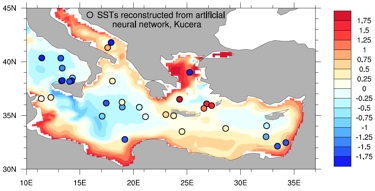|
Holocene climate dynamics and biogeochemical cycles in the Mediterranean Sea Principal Investigators: Gerhard Schmiedl (University of Hamburg), Kay-Christian Emeis (University of Hamburg), Ernst Maier-Reimer (MPI Hamburg), Uwe Mikolajewicz (MPI Hamburg)
Project Scientists: Fanny Adloff (MPI Hamburg), Rosina Grimm (MPI Hamburg), Jürgen Möbius (University of Hamburg)
SST anomalies (in K) reconstructed from proxy data (dots) vs. modelled temperature anomalies averaged between 0 and 32 m (background color) for summer months (JAS) for 9k.
We propose to study the chain of cause-and-effect leading from Holocene abrupt climate change to changed biogeochemical cycling in the Mediterranean Sea. We concentrate on this basin because it is a semi-enclosed ocean basin with very large amplitude reactions in the physical circulation regime to changes in the hydrological balance. The past variability of biogeochemical processes and marine ecosystems of this ocean is documented in the form of organic-rich sapropels that occurred at northern hemisphere insolation maxima. In order to understand the sensitivity of the Mediterranean Sea to high- and low-latitude climate forcing and to gauge the range of response to expected global change, we will model the Mediterranean Sea at times of climate extremes in the Holocene, including warm intervals (sapropel S1 maximum, Holocene Climate Optimum) and cold intervals (8.2 kyr event, 4.2 kyr “Old World Collapse”). Our Dual+ concept will be realized by the forcing and validation of global and regional Earth System model experiments with available proxy data. In the first phase proposed here, we will perform sensitivity tests with an ocean-only model deriving the potential changes in forcing (river runoff, changed evaporation/precipitation patterns, cooling/warming) from time slice simulations with a coupled earth system model. In the second phase we will test current hypotheses on biogeochemical processes that are a consequence of deep-water stagnation, oxygen drawdown, and addition of “new” nutrients. For this purpose we will couple promising model set-ups from phase 1 to a biogeochemical model (HAMOCC5) and perform sensitivity tests with nutrient sources and biogeochemical regimes. Again, the model results will be validated with proxy data. In future phases (to be applied for), we will perform transient simulations of the Mediterranean Sea for the period Younger Dryas to 9000 years ago (simulating the initiation of sapropel S1 formation), and perform time-slice experiments with meltwater events in a global model to elucidate teleconnections between the Mediterranean Sea and the (sub-)tropical monsoon and boreal climate systems. Finally, we plan for a transient experiment from the Younger Dryas to 4000 years ago that includes all promising scenarios from experiments above.
Stable Isotope Geochemistry, Biogeochemistry, Quantitative Micropaleontology, Coupled Ocean/Climate Modelling, Ocean Biogeochemistry Modelling
Archives
Marine records (Eastern and Western Mediterranean)
|
| < Prev |
|---|


